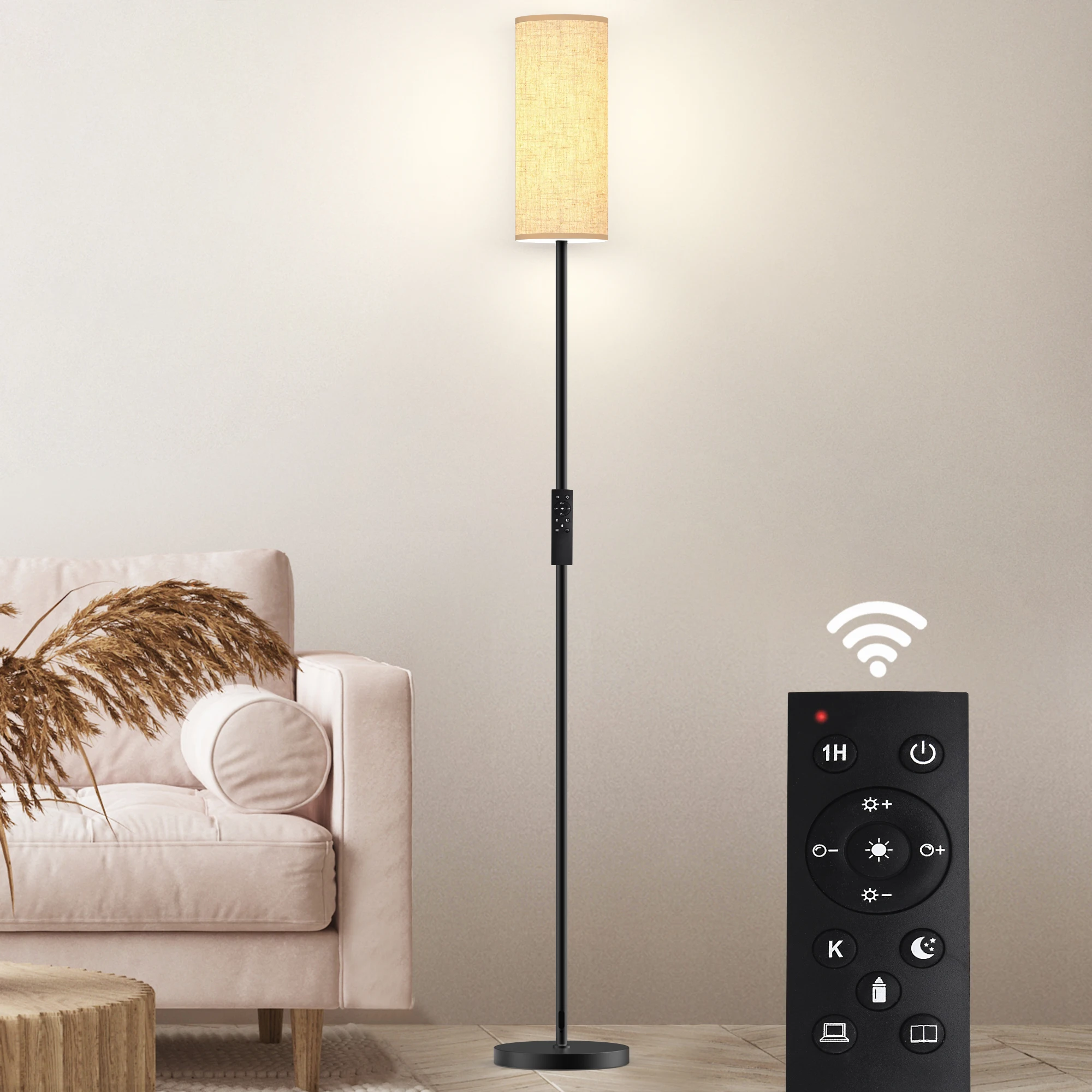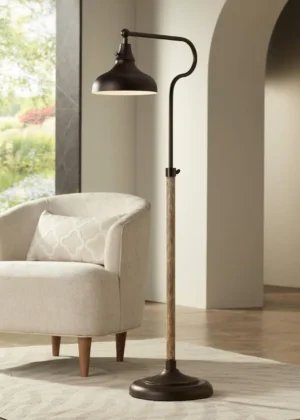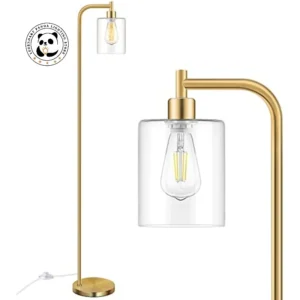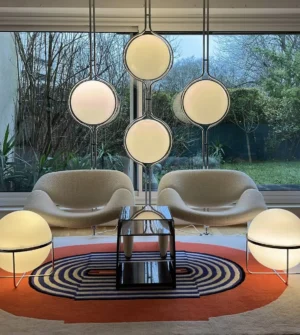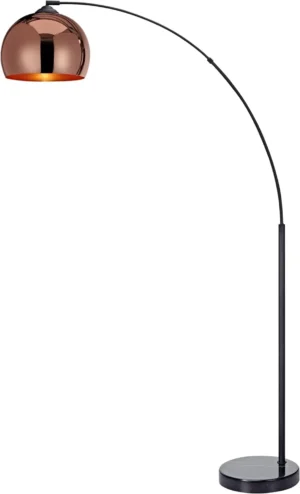1. Understanding Arc Lamps as Reading Light Solutions
Arc lamps stand out from traditional lighting fixtures thanks to their distinctive curved design that extends outward and over furniture. Unlike standard floor lamps that project light from a vertical pole, arc lamps feature a graceful arch that allows the light source to be positioned directly above your reading area without requiring ceiling installation.
What makes arc lamps particularly effective for reading corners is their ability to deliver overhead illumination without the need for hardwired ceiling fixtures. This unique design serves both practical and aesthetic purposes, creating a focal point in your room while providing targeted task lighting exactly where you need it.
Key benefits of arc lamps for reading include:
- Adjustable positioning that directs light precisely onto your reading material
- Elevated light source that minimizes shadows and glare
- Stylish alternative to traditional task lighting that enhances room decor
- Space-saving design that eliminates the need for end tables with table lamps
The proper positioning of your arc lamp is crucial for both eye comfort and the overall reading experience. By understanding how to optimize the placement, height, and angle of your lamp, you can create the perfect reading environment while showcasing the elegant design of these versatile fixtures.
Many readers find that adjustable arc floor lamps provide the most versatility, allowing you to fine-tune the light position based on your specific reading habits and furniture arrangement.
2. Essential Pre-Positioning Considerations
Before determining the ideal position for your arc lamp, take time to analyze your reading space and habits. This preparation will ensure your lamp serves both functional and aesthetic purposes effectively.
Evaluate Your Reading Space
- Seating type and dimensions: Different seating options require different lamp positions. Measure your armchair, sofa, or reading nook to understand the area that needs illumination.
- Reading posture: Consider whether you typically sit upright, recline, or change positions while reading.
- Available floor space: Map out at least 24-36 inches (61-91 cm) of clear space for the lamp base to ensure stability and prevent crowding.
Technical Requirements
- Power source accessibility: Identify nearby outlets and plan cord management to avoid creating tripping hazards.
- Lamp weight and stability: Heavier bases provide greater stability but require more floor space and may be harder to reposition.
- Traffic patterns: Position your lamp away from high-traffic areas to prevent accidental bumping.
- Ceiling height constraints: Ensure at least 8 inches (20 cm) of clearance between the highest point of your lamp and the ceiling.
Reading Material Considerations
The type of reading material you typically enjoy impacts optimal lamp positioning. Books with glossy pages require different light angles than e-readers or matte paper to minimize glare and maximize visibility.
Creating the perfect arc lamp reading nook involves balancing all these factors. Additionally, consider whether you’ll be reading during different times of day, as this affects the interplay between natural and artificial light.
For maximum flexibility, many readers prefer dimmable arc floor lamps that can be adjusted based on time of day and reading material. This adaptability ensures comfortable reading regardless of external lighting conditions.
3. Optimal Base Placement Options
Finding the ideal position for your arc lamp base is the foundation for comfortable reading. Here are the three primary placement options, each with distinct advantages:
Behind the Reading Chair/Sofa Placement
Ideal distance: Position the base 18-24 inches (45-61 cm) behind your seating.
Pros:
– Creates perfect overhead illumination
– Keeps base out of visual sightlines
– Minimizes floor space used in primary living area
Cons:
– Requires adequate space behind furniture
– May need wall clearance
– Can be more difficult to adjust once positioned
Side Placement Techniques
Ideal distance: Position 12-18 inches (30-45 cm) from the armrest.
Pros:
– Easier access for adjustments
– Works well in rooms with limited space behind furniture
– Can illuminate multiple seating positions
Cons:
– May create more noticeable shadows
– Takes up visible floor space
– Requires careful angle adjustment to avoid glare
Corner Placement Approach
Ideal distance: Position in room corner, angling the arc toward seating.
Pros:
– Maximizes space efficiency
– Creates visual interest in corner areas
– Provides good stability against walls
– Works well in smaller rooms
Cons:
– May require longer reach to illuminate central seating
– Less ideal for precise task lighting
– Limited adjustment options
The way you position an arc floor lamp should ultimately depend on your specific room layout and furniture arrangement. For optimal stability, particularly in homes with children or pets, consider marble base arc floor lamps that provide extra weight and security against tipping.
4. Perfecting the Arc Position and Height
Once your lamp base is positioned, fine-tuning the arc height and extension is crucial for optimal reading conditions.
Determining Optimal Arc Height
The general rule for reading light is to position the light source approximately 15-20 inches (38-51 cm) above eye level. This typically translates to:
- For upright reading: Light source at 48-54 inches (122-137 cm) from the floor
- For reclined reading: Slightly higher positioning at 54-60 inches (137-152 cm)
- For different furniture heights: Adjust accordingly—lower chairs require lower light positions
Remember that proper height prevents the light from shining directly into your eyes while providing adequate illumination on your reading material.
Arc Extension Calculations
To determine proper arc extension:
– Measure from the lamp base to the center of your reading material
– Ensure the arc extends far enough that the light source is positioned directly above your book or device
– Check that the extension doesn’t place the light behind your head, which would create shadows
For most seating arrangements, the arc should extend at least 20-30 inches (51-76 cm) from the base to position the light appropriately.
Adjusting Arc Direction
Fine-tuning the direction involves:
– Rotating the lamp head to direct light downward at approximately a 45-degree angle
– Positioning the shade so light focuses on your reading material without creating direct line-of-sight to the bulb
– Adjusting the arc curve to maintain proper height while achieving desired extension
Adjustable arc lamps for reading offer the most versatility, allowing you to modify height, extension, and direction as needed. This adaptability is particularly valuable if you read in different positions or share the reading space with others.
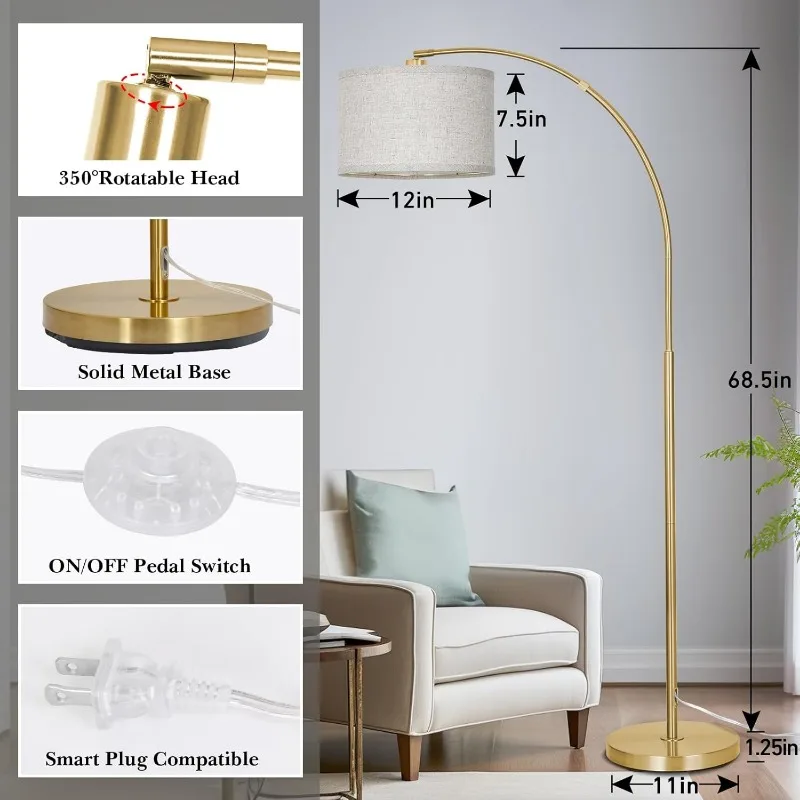
5. Light Direction and Focus Control
Achieving the perfect reading light involves more than just lamp placement—it requires careful control of light direction and focus.
Understanding Light Direction Principles
For optimal reading illumination:
– Position the light to shine at a 30-45 degree angle from vertical
– Adjust the lamphead so light spreads evenly across your reading material
– Test the focus by holding your hand above the page—you should see a clear, even shadow
The ideal reading light creates gentle illumination across the entire page without harsh bright spots or dark corners.
Managing Shadows and Eliminating Glare
To create comfortable, shadow-free reading light:
– Position yourself so your head doesn’t block the light path to your book
– Adjust the lamp height if you notice shadows from your hands or body
– For glossy materials or screens, angle the light slightly to prevent reflection bouncing into your eyes
– Use diffused rather than direct light when possible to minimize harsh contrasts
Accommodating Different Reading Scenarios
Your lighting needs may change based on:
– Multiple readers sharing space (position for broader coverage)
– Switching between physical books and digital devices (adjust brightness and angle)
– Moving between reading and other activities (consider lamps with adjustable brightness)
For the most consistent and eye-friendly illumination, many readers prefer LED arc floor lamps that provide even, flicker-free light with minimal heat output. LED options also typically offer longer lifespan and energy efficiency compared to traditional bulbs.
6. Selecting the Perfect Bulb for Reading
The right bulb choice dramatically impacts your reading comfort, regardless of perfect lamp positioning.
Bulb Type Recommendations
| Bulb Type | Pros for Reading | Cons for Reading |
|---|---|---|
| LED | Energy efficient, long-lasting, minimal heat | Some cheaper LEDs may cause glare |
| Halogen | Excellent color rendering, dimmable | Produces heat, shorter lifespan |
| CFL | Energy efficient, widely available | Slower to reach full brightness |
| Smart Bulbs | Adjustable brightness/color temperature | Higher cost, may require setup |
LEDs are generally the top choice for reading lamps due to their efficiency and quality of light.
Brightness Specifications for Comfortable Reading
For most reading situations:
– 400-800 lumens provides adequate brightness without causing eye strain
– Higher lumen values (600-800) are better for detailed work or aging eyes
– Lower lumen values (400-600) create a more relaxing atmosphere for leisure reading
Always select a bulb with a brightness level that allows comfortable reading without squinting or straining.
Color Temperature Selection
Color temperature significantly affects both reading comfort and mood:
– Warm white (2700K-3000K): Creates a cozy, relaxed atmosphere ideal for fiction reading and evening use
– Neutral white (3500K-4000K): Provides better detail visibility for textbooks, documents, or crafting
– Cool white (5000K+): Offers maximum contrast but can disrupt sleep patterns if used at night
Many readers find that floor lamps with focused reading capabilities and adjustable color temperature provide the most versatile lighting solution for different times of day and types of reading material.
7. Adjusting for Different Reading Activities and Times
Your arc lamp positioning may need refinement based on when and how you read.
Modifications for Extended Reading Sessions
For long reading periods:
– Position the lamp to allow occasional changes in your seating posture
– Adjust light intensity higher for detailed reading, lower for relaxed reading
– Consider repositioning as natural light changes throughout the day
Adapting for Different Reading Materials
Various reading formats require different approaches:
– For large-format books: Position the lamp higher and angled to cover the entire spread
– For digital devices: Lower brightness and adjust to minimize screen glare
– For detailed work or small print: Bring the light closer and increase brightness
Nighttime Reading Considerations
Evening reading requires special attention:
– Position the lamp to contain light to your reading area without illuminating the entire room
– Angle the light away from sleeping partners or others in shared spaces
– Choose warmer color temperatures (2700K-3000K) that interfere less with sleep hormones
– Consider dimming the light gradually as you prepare to transition to sleep
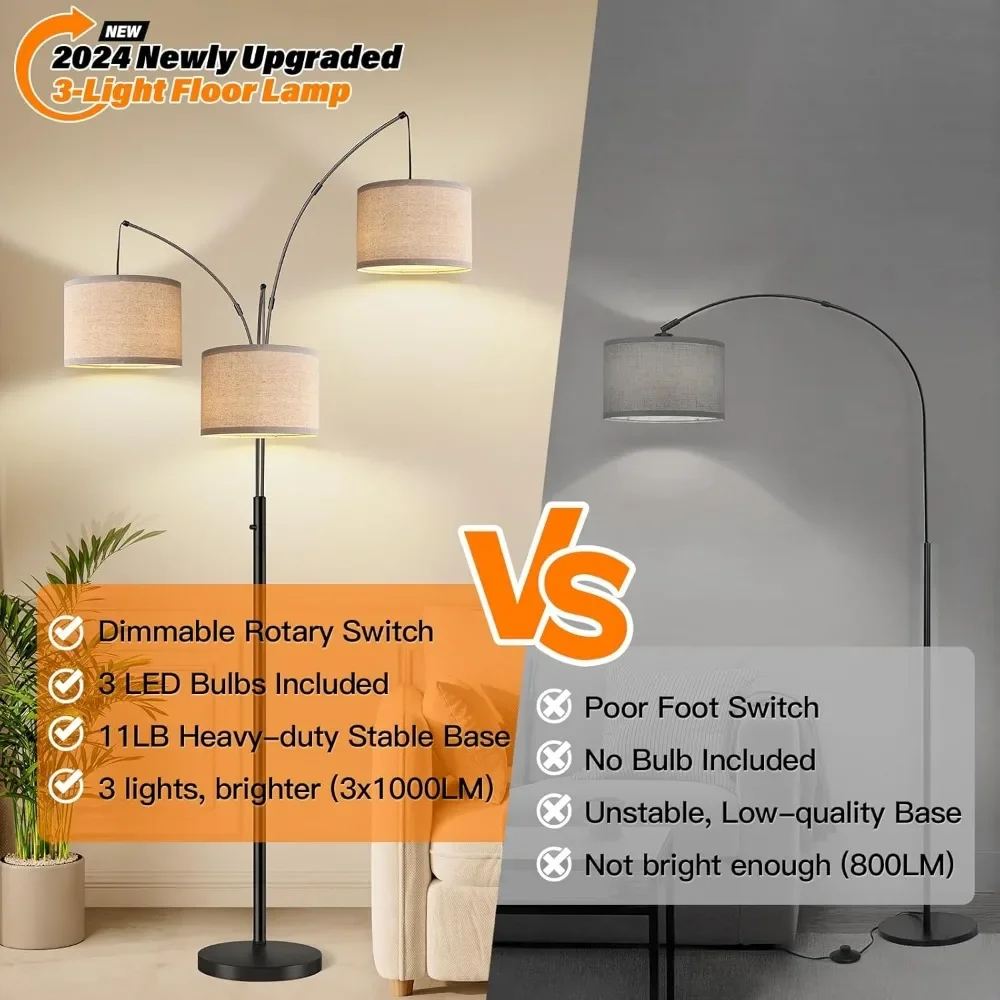
Many readers find that black arc floor lamps offer versatility for different reading scenarios while complementing most interior design styles.
8. Common Arc Lamp Positioning Mistakes to Avoid
Even the best lamp can cause discomfort if positioned improperly. Here are frequent errors to avoid:
Placement Errors That Create Glare and Eye Strain
Problem: Positioning the light source within your direct line of sight.
Solution: Move the lamp so the light source is above and slightly behind or to the side of your head.
Problem: Light reflecting off glossy pages creating bright spots.
Solution: Adjust the angle of illumination to 30-45 degrees rather than directly overhead.
Problem: Light that’s too harsh and direct.
Solution: Use a diffusing shade or adjust the lamp head for indirect lighting.
Distance and Coverage Mistakes
Problem: Lamp positioned too far from reading area, causing inadequate illumination.
Solution: Reposition base closer or extend the arc further over your reading space.
Problem: Light focused too narrowly, illuminating only part of your reading material.
Solution: Adjust height upward to create broader light spread or select a lamp with a wider shade.
Stability and Safety Oversights
Problem: Base positioned where it creates a tripping hazard.
Solution: Route foot traffic away from the lamp base or choose corner positioning.
Problem: Unstable setup on carpet or uneven flooring.
Solution: Use a larger base model or place on a firm surface to prevent tipping.
Light Quality Miscalculations
Problem: Light that’s too bright, causing eye fatigue.
Solution: Install a dimmer switch or choose a lower lumen bulb.
Problem: Light that’s too dim, requiring strain to read.
Solution: Increase bulb brightness or adjust lamp closer to reading material.
For more comprehensive guidance on creating an ideal reading environment, explore our guide to perfectly lighting reading corners that combines multiple lighting principles.
Adjustable Arc Floor Lamp, Bronze Arc Floor Lamp
Price range: $440.95 through $558.52 Select options This product has multiple variants. The options may be chosen on the product pageBrass Arc Floor Lamp, Contemporary Arc Floor Lamp, LED Arc Floor Lamp
Price range: $490.72 through $522.04 Select options This product has multiple variants. The options may be chosen on the product pageChrome Arc Floor Lamp, LED Arc Floor Lamp
Price range: $304.95 through $1,210.40 Select options This product has multiple variants. The options may be chosen on the product pageContemporary Arc Floor Lamp, Large Arc Floor Lamp, Marble Base Arc Floor Lamp
$224.94 Select options This product has multiple variants. The options may be chosen on the product pageLED Arc Floor Lamp, Rattan Arc Floor Lamp
$313.58 Select options This product has multiple variants. The options may be chosen on the product page- $1,003.85 Select options This product has multiple variants. The options may be chosen on the product page
9. Arc Lamp Positioning for Special Reading Environments
Different living spaces require tailored approaches to arc lamp positioning.
Small Space Solutions
When working with limited floor area:
– Consider wall-adjacent positioning to minimize footprint
– Select models with smaller bases but adequate stability
– Position the lamp where it can serve multiple purposes (reading light plus ambient lighting)
– Utilize corner spaces that might otherwise go unused
Open Concept Area Strategies
In larger, open spaces:
– Use the arc lamp to visually define your reading zone within the larger area
– Position to complement other light sources without creating competing brightness
– Consider the lamp’s visual impact from all viewing angles in the open space
Creating Designated Reading Nooks
To establish a dedicated reading area:
– Position the arc lamp as a defining element of your reading nook
– Combine with comfortable seating and perhaps a small side table
– Angle the light to create a sense of intimacy within the larger room
Many interior designers recommend considering whether lamps should be in corners as this placement often maximizes both function and visual appeal, particularly in smaller spaces or rooms with multiple activity zones.
10. Aesthetic Integration Without Compromising Function
A well-positioned arc lamp enhances both your reading experience and your room’s visual appeal.
Balancing Visual Impact with Reading Functionality
Consider how your lamp:
– Creates a visual statement while delivering practical illumination
– Complements the scale of your furniture (larger seating typically pairs well with dramatic arc designs)
– Frames views rather than obstructing them
Creating Visual Harmony
For cohesive design:
– Align the arc lamp with existing design lines in your room
– Consider how the lamp’s curve relates to other rounded or angular elements
– Use the lamp to echo shapes found elsewhere in your decor
Managing Visual Weight in the Room
To maintain balance:
– Position larger, more dramatic arc lamps in spaces with adequate visual “breathing room”
– Use the lamp’s placement to draw attention to architectural features or away from less desirable areas
– Consider the lamp’s finish and how it relates to other metals or materials in the room
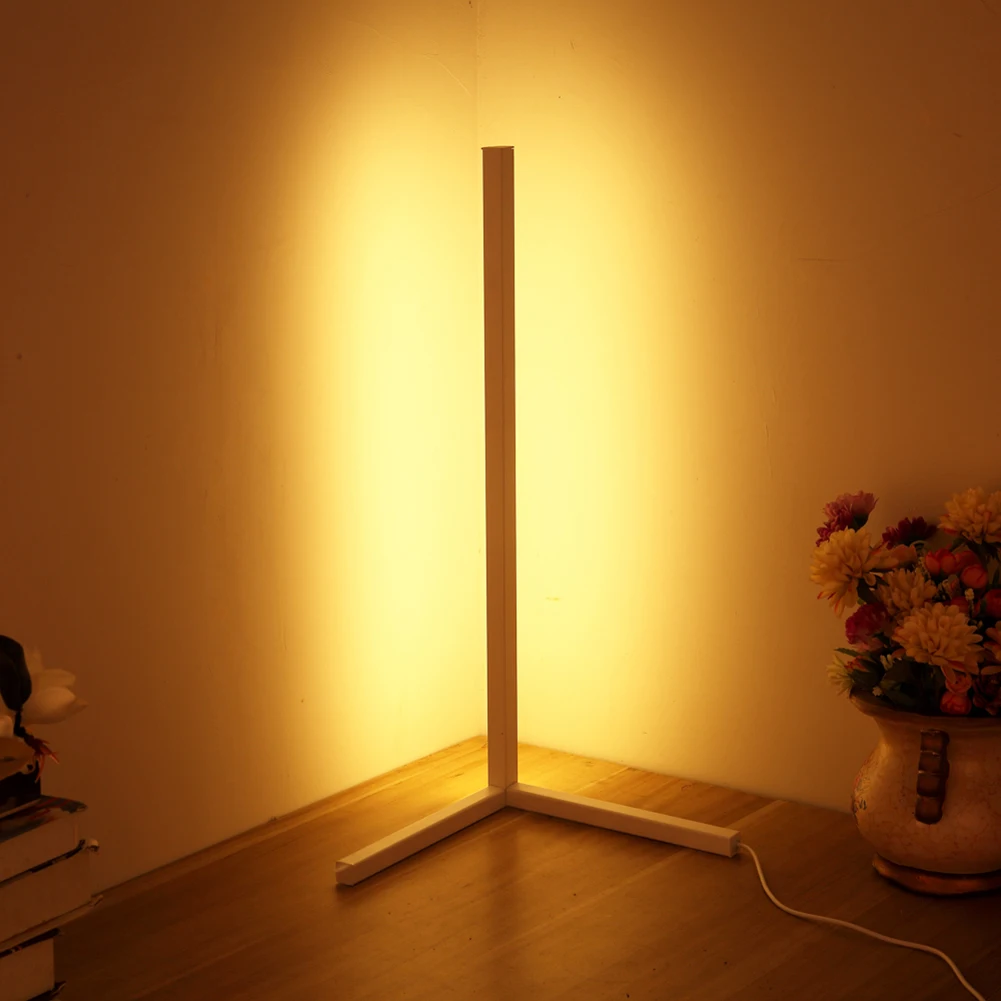
For rooms where both stability and aesthetics matter, learning how to stabilize arc floor lamp bases ensures your perfect positioning remains secure over time.
11. Is Your Arc Lamp Too Tall for Your Space? Adaptation Strategies
Evaluating Height Compatibility
How to determine if your arc lamp is too tall:
– Measure ceiling clearance (minimum 8-10 inches or 20-25 cm recommended)
– Look for signs of awkward proportions relative to other furniture
– Check if the lamp appears to dominate the room visually
Solutions for Excessive Height
If your arc lamp doesn’t fit your ceiling height:
– Position away from the lowest ceiling points in sloped or beamed spaces
– Consider shorter arc models designed specifically for lower ceilings
– Place the lamp where the arc extends from a higher to a lower ceiling area
– Adjust the arc to a less pronounced curve if your model allows
For creating a comfortable reading environment with optimal lighting levels, explore our ultimate guide to soft lighting with arc lamps that addresses various ceiling height challenges.
12. Should You Adjust Your Arc Lamp Seasonally? Optimizing for Natural Light Changes
Understanding Seasonal Light Interactions
Natural light varies significantly throughout the year, affecting your reading environment:
– Winter brings shorter days and more angled sunlight
– Summer provides longer daylight hours but potentially more glare
– Seasonal shifts change how shadows fall in your reading space
Seasonal Positioning Strategies
Optimize your arc lamp position seasonally:
– Winter: Position for earlier activation and longer evening use
– Summer: Adjust to complement natural light and manage heat from windows
– Spring/Fall: Create flexible positioning that accommodates varying light conditions
Small seasonal adjustments to your lamp’s position can significantly enhance reading comfort as natural light patterns change. The process of choosing the perfect reading lamp should include consideration of how your space’s lighting needs evolve throughout the year.
13. How Can You Position Multiple Light Sources with an Arc Lamp?
Layering Light Effectively
When combining an arc lamp with other light sources:
– Position your arc lamp as the primary task light for reading
– Ensure ambient room lighting complements rather than competes with your reading light
– Create distinct lighting zones for different activities within the same space
Balancing Multiple Task Lights
If you need additional task lighting:
– Position your arc lamp as the primary overhead source
– Add smaller, secondary lights for peripheral tasks
– Ensure light sources don’t create multiple competing shadows
– Establish a visual hierarchy with your arc lamp as the dominant lighting element
For maximum flexibility in creating layered lighting, 3-light arc floor lamps allow you to direct illumination to multiple areas or adjust brightness levels for different purposes within your reading space.
14. Fine-Tuning Your Arc Lamp Position: When to Make Adjustments
Recognizing Signs of Poor Positioning
Watch for these indicators that your lamp needs repositioning:
– Eye strain or headaches after reading
– Constantly shifting position to see better
– Shadows that interfere with seeing text clearly
– Difficulty maintaining a comfortable reading posture
When to Reposition
Consider adjusting your arc lamp when:
– You rearrange furniture or change your primary reading seat
– You switch between different types of reading materials (physical books to e-readers)
– Seasonal light changes affect your reading environment
– Your vision needs change over time
Regular fine-tuning ensures your reading light continues to serve you well as your needs evolve. For ongoing optimization of your reading environment, our ultimate guide to reading arc floor lamps provides comprehensive advice for maintaining perfect lighting conditions year-round.

